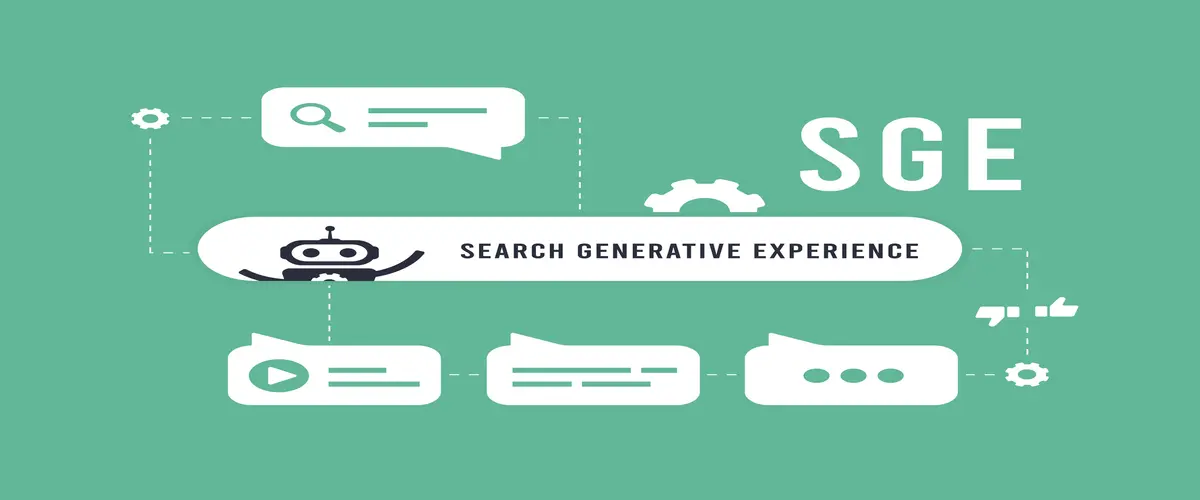
Google SGE (Search Generative Experience) is a new chapter in the chronicles of AI for general public use. The plot first gained momentum in November 2022, when ChatGPT became available to the masses, and millions of internet users rushed to try out the new technology. The result? Widespread use of conversational and generative AI is now a reality. Today, ChatGPT has many competitors: Gemini for effective text generation, Perplexity for sources and quotations and Midjourney or Dall-E for creating images, to name but a few. All these chatbots require direct action from the user: create an account, connect to a specific URL, make a payment, etc.
Providing artificial intelligence services without requiring input from the internet user marks a new era. Microsoft laid the groundwork for this in February 2023 when it integrated Bing Chat into its search engine. Google’s response was swift, and it launched its Search Generative Experience in November 2023 — an innovation that raises a lot of questions.
- What exactly is Google SGE?
- What are its capabilities?
- What countries is it available in?
- Is SGE reliable?
- How does SGE impact SEO?
- How can you prepare your website for Google SGE?
As specialists in multilingual content for international websites, Milega is keen to explore all these questions, and now we’re here to give you the lowdown!
What exactly is Google SGE?
Search Generative Experience starts just like any other standard Google search. However, the suggested results are enhanced by AI, and a response to the query is offered directly on the SERP. Here’s an example:

The response generated by Google SGE appears in a coloured box above the organic results. Since the 14th of May 2024, this box has been called ‘AI Overviews’. To the right, a carousel shows reliable sources. This is a major development in that the search engine no longer just offers a list of sites containing the information you’re looking for. With AI Overviews, it delivers the information itself!
What are Google SGE’s capabilities?
As well as responding to an information request, Google SGE features a range of additional capabilities:
- “Ask a follow up” function.Users can refine their search without leaving the results page. They can either click on one of the suggested questions or formulate a new one. The AI then works in conversational mode.
- Image generation.Google SGE will generate 4 images based on a text description.
- Text generation. Like Gemini or ChatGPT, Google SGE can generate text that meets multiple requirements (content, style, language levels, etc).
- Shopping assistance. When the query contains a purchase intention, AI Overviews proposes a selection of products, along with visuals, prices, reviews, shop locations, etc. To appear in the AI Overviews box, the site’s content must clearly respond to a transactional intention. It’s therefore essential to identify your audience’s search intent for SEO.
- Refined translation.If a word to be translated has several meanings, Internet users can specify which one is appropriate. For example, when translating “I don’t like squash”, you can specify whether “squash” refers to the vegetable or the activity. This is particularly useful for individual users. However, when translating your multilingual website content, it’s better to use professional language services like those offered by Milega. Our expertise in SEO localization will prove to be a major asset when it comes to adapting your translations to the local context of the target country.
- “Ask with video” function. This is an amazing new feature. It allows you to ask a question based on a personal video. For example, you could film a warped bike wheel and ask how to fix it.
What countries is Google SGE available in?
After initially launching in the United States, India and Japan, Google SGE has now expanded into over 120 countries, including Indonesia, South Korea, Brazil, Mexico, South Africa and even Nigeria…
What about Europe? Google hasn’t yet set an official timetable for when this new tool will become available. European regulation, and more specifically, the DMA, is likely behind this uncertainty. The DMA (Digital Market Act) seeks to regulate the power of digital giants in the European Union. As a result, many GAFAM companies face regulations and obligations when expanding into Europe. These legal obstacles will no doubt be overcome, and France should soon be able to experiment with the new Google search.
Does your multilingual site target both countries with Google SGE and those that are yet to receive it? Then it’s essential to handle the SEO translation of your content carefully and to use transcreation services. Don’t think twice about using an agency of multilingual experts like Milega.
Is Google SGE reliable?
Google SGE’s reliability still seems uncertain. AI Overviews has been displayed by default for all Google searches in the United States since the 14th of May, and it didn’t take long for some of the absurd answers it produced to be shared and mocked on social media. Screenshots show that it recommends eating at least one small rock per day and using glue to stick cheese to pizza! Less amusing is a screenshot showing it suggests jumping off a bridge to cure depression. While there are undoubtedly some fakes amongst these screenshots, many of them are true.
Google is actively trying to resolve this problem. AI hallucinations aren’t uncommon — we all remember ChatGPT 3 stating that cow’s eggs are bigger than chicken’s eggs — and the source from which the information is taken sometimes explains these kinds of blunders. AI Overviews considers sites with a good authority score (that is, with a high volume of traffic and backlinks). In the examples we see above, it’s drawn information from Onion, a popular parody site, and Reddit, which publishes both serious and humorous articles. In short, like its counterparts, Google’s AI doesn’t quite know how to spot a joke yet, and this partly explains its relative reliability.
How does SGE impact SEO?
The roll-out of Google SGE is likely to disrupt organic traffic and SEO.
However, AI Overviews has little effect on organic results. A study by Empirik reveals that for 98% of the keywords tested, the position of organic links is identical, or almost identical, to that obtained with SGE. The major change concerns their visibility on the screen. The first organic results appear after the AI Overviews box, which is itself preceded by the sponsored results. Consequently, they often appear below the fold. This could significantly reduce the click-through rate. Considering this new layout, the top spot for visibility is going to be the carousel of reliable sources on the right-hand side of the box, and this promises to be a highly coveted position.
Which sites appear on the SGE carousel?
The sites displayed in the AI Overviews box are not the same as those that appear in the top 10 organic results. In fact, there’s almost never a perfect similarity between the 2 lists, and in 35% of cases, there’s no page that appears on both. Therefore, the optimization levers for Google SGE will be different. The carousel favours sites that are highly specialized in a particular field as well as the accuracy of information and the EEAT value (Experience, Expertise, Authoritativeness and Trustworthiness). As a result, sites that are poorly referenced in the organic results can appear among the reliable sources in the AI Overviews box.
What does AI Overviews mean for e-commerce sites?
The Empirik study provides some interesting insights:
- The difference between the classic SERP and the carousel is even more marked for e-commerce sites. Only a quarter of the sites in the carousel also appear in the top 10 organic results.
- The e-commerce sites that appear in the AI Overviews box have an optimized content flow, high added value, and structured data.
- For transactional queries, 78% of links featured in AI Overviews lead users to Google products.
How can you prepare for SGE?
Multilingual sites in the era of SGE
All the above data was collected on Google’s US search engine. The United States is currently the only country where the AI Overviews feature is systematically deployed for all Google searches, and this is far from becoming a reality across the pond in Europe. It’s more important than ever for international websites to adopt good SEO strategies that are tailored to each individual country. To guarantee your visibility across all markets, good practices are essential:
- SEO translation
- Transcreation
- Content localization
- Content tailored to user intent
Milega specializes in all these areas, so you can count on our services for your international and multilingual website. With our expertise, you’ll be able to navigate Google SGE with confidence.
Should monolingual European sites be prepared for SGE?
Even if your website hasn’t opened its doors to the international market, it’s not too early to anticipate the arrival of AI Overviews. Here are a few tips for launching a new SEO strategy:
- Offer content targeting long-tail keywords. They’re more likely to respond to queries formulated in natural language on Google SGE.
- Structure your h2 and h3 in the form of questions.
- Use structured data, which is well-suited to AI Overviews.
- If you own a specialized website, it’s time to develop your EEAT. Offer in-depth content and ensure the quality of your inbound and outbound links.
Are you concerned that the arrival of Google SGE will cause you to lose visibility? Then it could be time to think about internationalizing your site. Don’t hesitate to ask us for advice.
Understanding how Google SGE works and preparing for its arrival is vital. However, let’s not forget that web content isn’t intended for AI. It’s intended for human internet users. Content needs to be tailored to them first and foremost, not algorithms. After all, only by satisfying your audience will your site reap the rewards.
Would you like to share your products, knowledge or expertise with the world via the Internet? Get in touch, and we’ll help you make your project a reality!






